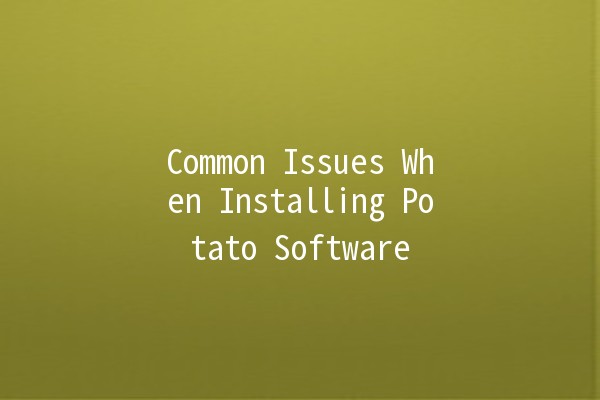Installing software can often be a daunting task, particularly when encountering unexpected issues. Potato Software, an innovative application designed to enhance user productivity, can sometimes present unique challenges during installation. This article aims to highlight some common problems users face and provide practical tips to resolve them effectively. By understanding these issues and their solutions, users can navigate the installation process smoothly.
Before diving into the installation process, it’s crucial to ensure that your system meets the basic requirements needed to run Potato Software. Many issues stem from compatibility problems, which can make the installation process frustrating.
Key Requirements to Check:
Operating System: Verify that your operating system version matches the requirements specified by Potato Software. For example, if the software is designed for Windows 10 and you’re running Windows 8, installation may fail.
RAM and Storage Space: Ensure that your device has enough RAM (usually at least 4 GB recommended) and sufficient storage space for the installation files and the software itself. A lack of space can lead to incomplete installations and software crashes.

Dependencies: Some software packages require specific libraries or runtimes (like .NET Framework for Windows users). Installing these prerequisites before running the installation package can save you a lot of headaches.
Tip: Always refer to the official website or documentation for the most accurate requirements and recommendations for installation.
Another common issue occurs during the download phase. Users often download installation files from unverified or thirdparty websites, leading to corrupted files or malware.
Best Practices for Safe Downloads:
Official Sources: Always download Potato Software from its official website or trusted app stores. This minimizes the risk of downloading infected or tampered files.
File Integrity Verification: If possible, check the hash of the downloaded file against the hash provided by the source. This confirms that the file is unaltered and complete.
Example: Consider a scenario where a user downloaded Potato Software from a dubious site. During installation, they encountered multiple error messages due to a corrupted installer. If they had downloaded from the official site, they could have avoided this issue altogether.
Sometimes, security software may mistakenly identify the Potato Software installation process as a potential threat, blocking it from proceeding.
Steps to Mitigate the Issue:
Temporarily Disable Antivirus: Before installation, you may choose to disable your antivirus software temporarily. Be sure to enable it again after the installation is complete.
Add an Exception: Rather than disabling your antivirus, you could add the installation file or folder to the exceptions list, allowing the installation to proceed without interference.
Practical Example: If a user tries to install Potato Software only to be interrupted by their antivirus, temporarily disabling the antivirus could allow for a smooth installation.
Note:
Make sure to reenable your antivirus software as soon as you confirm the installation is finished to keep your system protected.
Users may find that the installation process hangs or becomes unresponsive. This can be frustrating and often leads to canceled installations.
Solutions to Resolve Hanging Installations:
Close Background Applications: Before starting the installation, close unnecessary background applications that might consume CPU or memory resources, slowing down the installation.
Run as Administrator: Some installations require administrative privileges. Rightclick the installer and select “Run as administrator” to give it the necessary permissions.
Example: A user with a PC running several resourceintensive applications might find that the installation hangs. Closing these apps before proceeding will often resolve the problem.
Postinstallation, users may encounter errors that prevent them from using Potato Software. This could happen due to incorrect installation or missing components.
How to Fix PostInstallation Errors:
Repair Installation: Many software programs, including Potato Software, provide an option to repair the installation. Running this repair can restore missing or corrupted files.
Check for Updates: Sometimes, manufacturers release patches or updates shortly after installation. Ensuring you have the latest version can rectify many lingering issues.
Practical Application: A user finds themselves unable to open Potato Software after installation due to missing files. After using the repair tool, they find that the issue is resolved.
Should users continue to face difficulties even after following the previous troubleshooting steps, utilizing support channels for additional help is key.
Available Support Options:
Official Support Forum: Potato Software often has a community forum where users can post their issues, and developers or other users provide solutions.
Email or Chat Support: Consider contacting the official support team directly via email or live chat for personalized assistance regarding persistent issues.
al Thoughts:
When installing Potato Software, being proactive by ensuring compatibility, downloading from trusted sources, and addressing simple installation hangups can make a significant difference. By employing these techniques, users can minimize frustrations and enhance their productivity while using the software.
FAQ Section
If your installation fails, check error codes that may appear on the installation screen. Visit the Potato Software support page for detailed troubleshooting steps based on specific error messages.
You can confirm the version by checking the download page against the version installed on your device. Look out for version release notes that accompany the download.
Yes, Potato Software requires a minimum of 4GB of RAM and a modern multicore processor for optimal functionality. Refer to the software’s specifications for detailed requirements.
If Potato Software crashes frequently, ensure you have the latest updates installed. You might also want to check your system specifications against the software's requirements.
Most software programs allow a onetime transfer of licenses. However, you should consult the licensing agreement or contact customer support for specific policies.
While the latest version of Potato Software may only be supported on the latest operating systems, older versions may be compatible. Review official documentation for versionspecific support.
By becoming familiar with these common issues and their resolutions, users can effectively manage their Potato Software installations, ensuring a smooth setup process and enhanced productivity.